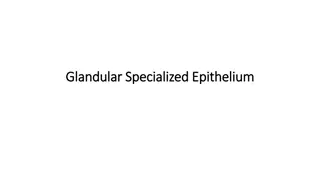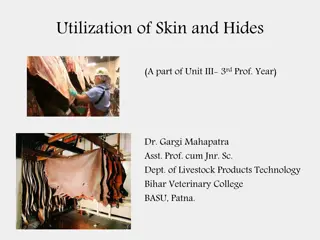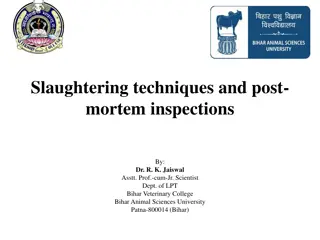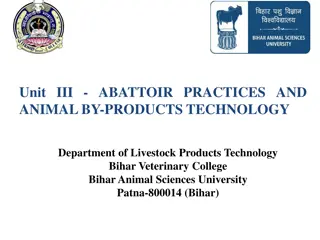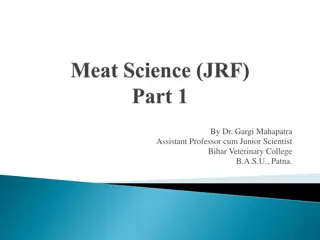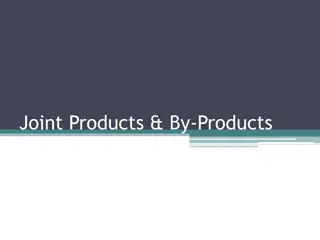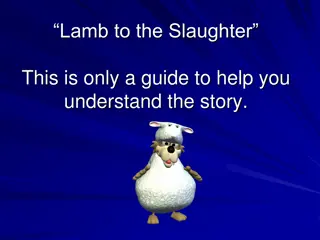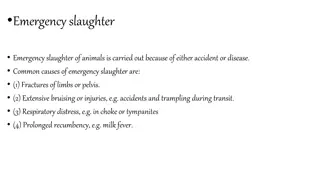Utilization of Glandular By-Products in Slaughter Technology
Animal glands, rich in healing substances, are valuable by-products in the pharmaceutical industry. This article emphasizes the overlooked potential for utilizing glands in India, focusing on collection and preservation methods to maintain the efficacy of hormones and enzymes extracted for medicinal purposes.
Download Presentation

Please find below an Image/Link to download the presentation.
The content on the website is provided AS IS for your information and personal use only. It may not be sold, licensed, or shared on other websites without obtaining consent from the author. Download presentation by click this link. If you encounter any issues during the download, it is possible that the publisher has removed the file from their server.
E N D
Presentation Transcript
LPT BYPRODUCTS 606: SLAUGHTER TECHNOLOGY HOUSE (2+1) UNIT I UTILIZATION OF GLANDULAR BYPRODUCTS Dr. R. K. Jaiswal Asstt. Prof.-cum-Jr. Scientist Dept. of Livestock Products Technology Bihar Veterinary College Bihar Animal Sciences University Patna-800014 (Bihar)
Glandular by-products Animal glands have been used in medicine for their healing powers Internally secreting, ductless glands called endocrine glands 0.28% of the animal's live weight Digestive enzymes obtained from GIT and organs Hormones and enzymes are extracted from animal by-products for pharmaceutical and medicinal purposes
Scope for utilization of glands in India Collection and utilization of animal glands is neglected in India Establishment of such a highly beneficial industry in this country should receive national importance Unprocessed glands were also imported from abroad for the preparation of glandular products in India Utilization of glands is economically possible only in large cities such as Mumbai, Kolkata, Chennai, Delhi, Hyderabad, Baroda, etc., where large numbers of animals are slaughtered.
Collection of glands Glands should be collected from healthy animals Removed within half -an hour after slaughter Not removed immediately, the hormones will deteriorate rapidly Butchers, generally, do not remove the glands immediately : all active principles of the glands are destroyed by autolysis Glands after removal should not be washed but may be rinsed quickly with cold water After removal, the gland should be frozen without any delay.
Preservation of glands Preservation applicable to all glands is freezing within an hour of collection and deliver them in a frozen condition to the pharmaceutical producers Glands like pancreas, pituitary, thyroid, adrenal, etc., may be preserved by chemical means as for instance by immersing one lbs of gland in 1 lb. of acetone. After 24 hours the glands must be removed and placed in fresh acetone. The used acetone is then purified and used again.
In this process, the enzymes are inactivated and thus shelf-life is increased. Fatty material, which generally interferes with the extraction of most proteins, is also eliminated. The desired protein from the acetone can be directly extracted with usual solvents. The requirement of solvent is also minimized. Percent phenol or percent formalin is sometimes used.
Pancreas Insulin enzymes, which are used by industry Mixed type of gland. Insulin is the main hormone, from the beta-cells with the help of acidified methanol. and other tanneries extracted
One kg of fresh bovine or pig pancreas yields about 150 mg of crystalline insulin with an activity of 254 IU/mg of insulin. Other biochemicals extracted from pancreas are: Pancreatin (Extract of pancreas) Trypsin Chymotrypsin Amylase Glucagon (alpha-cells)
Supra renal or adrenal This gland is of two parts outer cortex and inner medulla. Cortex yields corticosteroids, which are used in the treatment of Edison s disease, to overcome shock in surgery and as a non-specific treatment. Medulla of adrenal glands yields adrenaline and nor- adrenaline hormones. Yield of adrenaline is 0.2% on fresh weight basis and 1% on dry weight basis. It is extracted in water or alcohol.
Thyroid and Parathyroid gland Thyroid glands are two maroon coloured bodies situated on either side of trachea. Acetone dried powder of this gland is used to extract thyroxine hormone with the help of Barium hydroxide. Yield of the hormone is 0.08%. Parathyroid are located near thyroid gland. Parathromone is extracted from them. It is used in the prevention of tetany and increase to the rate of calcium excretion.
Pituitary gland Anterior lobe hormones: Growth hormone, FSH, LH, ACTH and MSH Posterior lobe hormones: Oxytocin & Vasopressin Oxytocin This can be extracted in 2 % acetic acid. It initiates the uterine contraction and also milk-ejecting factor. Vasopressin
Ovaries These are collected only from mature animals i.e. those having corpus lutea. Ovaries are irregular, lobulated in appearance with large follicles projecting like small grapes. All ovaries with cysts are discarded. Sex hormones estrogen and progesterone are extracted from ovaries.
Testes Also known as Fries/Mountain Oyster Collected from mature animals that have been passed in antemortem examination inspection. Testosterone, a sex hormone is extracted from testes. Hyaluronidase enzyme is made from bull or ram testes. It is a very good spreading factor and used in several drugs to intensify their effect. and postmortem
Stomach glands Rennin or rennet: Enzyme obtained from the lining of fourth stomach (abomasum) of milkfed calves. The abomasum is cut out, packed and frozen without any washing. Pepsin: This is an enzyme obtained from the mucosal lining of the hog stomach. Pink-red colour wrinkles and folds distinguish this part of hog stomach.
Situated between the folds. The hog stomach is cut and the glandular linings are pulled away from the stomach wall and frozen as quickly as possible. These can be preserved in 1% H2SO4 or the acetone-dried powder of the glands can be stored at room temperature but very low temperature is required during its preparation. Peptone can be prepared from the remainder part of the hog stomach.
Gall bladder It is attached to liver and contains bile, a dark golden- greenish viscous fluid of bitter taste. Bile is slightly alkaline (pH 7.15) and has a specific gravity of 1.025. It can be used as detergent in slaughter in slaughterhouses by dissolving in warm water (1:5 v/v). Dried bile has medicinal use as a substitute in secretion deficiencies. One kg of bile can be obtained from the gall bladder of 6 buffaloes or 55 sheep/goats, stored frozen.
Future Scope Increased modernization of slaughterhouse for effective utilization of glandular byproducts. Many synthetic preparations have been evolved, but products from natural resources are still cheaper. Efforts are being made to create adequate facilities for the timely collection, immediate freezing and create trained manpower for preliminary processing of these glands in our country. Various research laboratories themselves to develop new processes and improve the existing technologies. are equipping







